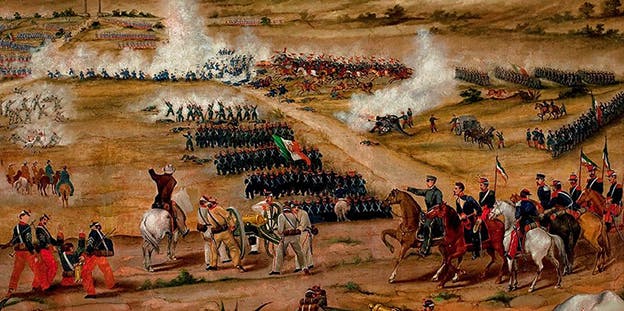History of Cinco de Mayo
Cinco de Mayo Battle. Rosa Mexicano, Bentobox, www.rosamexicano.com/event/what-is-cinco-de-mayo/. Accessed 25 Apr. 2021.
May 7, 2021
The widely celebrated American holiday of Cinco de Mayo, or “Fifth of May” in English, has come and gone as we approach the end of the 2020-21 school year. Because many American families celebrate Cinco de Mayo with family and friends, it’s important to read up on the history of this holiday and understand how this celebration came to be recognized in the United States.
One big misconception about this holiday is that it originated as Mexico’s Independence Day; it actually came about as a celebration of the Mexican army’s victory against a French army of 6,000 (outnumbering the Mexican army by about 4,000 men) on May 5, 1862, at the city of Puebla. Despite its widespread popularity in the United States, the battle was actually only a minor victory and is celebrated locally in Puebla, Mexico. As it is not a formal Mexican federal holiday due to its locality, offices, businesses, and schools remain open. A more established holiday is Mexico’s Independence Day on the 16th of September, called Día de la Independencia, in celebration of the country’s independence from Spain after decades of fighting for freedom. Día de la Independencia actually originated in 1810, half a century before the events of Cinco de Mayo.
So, what exactly happened on May 5, 1862, and why is the anniversary of Cinco de Mayo more celebrated in the United States than in Mexico?
In 1861, Benito Juárez was elected President of Mexico and was subsequently faced with mountains of foreign debt after decades of internal financial struggle. Mexico was forced to declare a temporary moratorium on repayment of these debts to various European countries like France, Britain, and Spain. In response, the French, English, and Spanish governments sent troops to invade the country and force repayment of debts. As the troops met with the Mexican government in Veracruz, Mexico, negotiations were made with Britain and Spain, but failed to materialize with France. With the support of wealthy landowners and other elites, French leaders under Napoleon III saw the opportunity to seize parts of Mexican land, profit from the conflict, and potentially decrease United States influence and power in the American continents. A fleet of French troops led by General Charles Latrille de Lorencez then stormed Veracruz in late 1861, driving back President Juárez and other government officials and forcing them to retreat. However, Juárez was able to assemble a force of about 2,000 loyal men, made up mostly of indigenous or mixed-race Mexicans, who then, led by General Ignacio Zaragoza, set out to defend the city of Puebla against the French troops. The Mexican troops were poorly supplied and vastly outnumbered; yet, against all odds, they managed to drive back the French. There were about 500 to 1,000 French casualties and 100 Mexican casualties.
Such a victory over the French in the face of certain defeat raised Mexican spirit and incited hope that the French would eventually be driven out of Mexican soil for good. Although the battle was by no means a majorly strategic win, it quickly became a symbol of resistance against foreign influence for the Mexican people, and the French were finally defeated five years later. Puebla was also later renamed to Puebla de Zaragoza after General Zaragoza.
To reiterate an earlier statement, Cinco de Mayo is primarily celebrated in the city in which the battle was won, although other parts of Mexico do celebrate it as well. The holiday’s popularity in the United States is largely due to 1960s Chicano activism that promoted it due to its symbolic victory of indigenous populations over foreign influence. Mexican immigrants began to see it as an opportunity to celebrate their heritage. However, the holiday did not truly take hold in the majority of the American population until businesses saw it as an opportunity to promote Mexican alcoholic drinks in the United States.
Today, many Americans only see Cinco de Mayo as an opportunity to drink and party with friends and family, despite a lack of knowledge behind the history of the holiday or the culture of Latino and Mexican American communities. So, if you or your family decide to celebrate Cinco de Mayo, remember to treat the holiday with respect by learning more about Mexican American history and refraining from mocking or appropriating Mexican culture or clothes. Cinco de Mayo is a great opportunity to celebrate the rich Hispanic culture that we as a country inherit from Mexico: music, food, language, art, and so much more!
Works Cited
Britannica, The Editors of Encyclopaedia. “Cinco de Mayo.” Encyclopedia Britannica, 5 Mar. 2021, https://www.britannica.com/topic/Cinco-de-Mayo. Accessed 25 April 2021.
“Cinco de Mayo.” HISTORY, A&E Television Networks, 23 Oct. 2009, www.history.com/topics/holidays/cinco-de-mayo. Accessed 25 Apr. 2021.
Cinco de Mayo Battle. Rosa Mexicano, Bentobox, www.rosamexicano.com/event/what-is-cinco-de-mayo/. Accessed 25 Apr. 2021.

